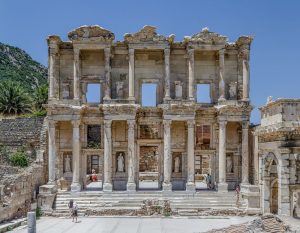The Library of Celsus was a storehouse of more than 12,000 scrolls and was a magnificent structure during its time. It is located in ancient Ephesus, now part of modern-day Turkey. Ephesus was a bustling Roman city that attracted travelers and merchants, and it was perhaps inevitable that a public library flourished there. The ruins of the library now stand as a testament to Ephesus being an epicenter of knowledge.
History
Construction of the library began in 114 on the orders of a consul named Tiberius Julius Aquila. He wanted a library to immortalize his father, Tiberius Julius Celsus Polemaeanus, who had died that year. Celsus had been a respected member of the Roman Senate, aside from serving as consul in Rome and as governor of Asiana. He became a wealthy and well-loved citizen of Ephesus, and his son, Aquila, thought it was fitting to build a library in his father’s honor. Before his death, Celsus had left a large amount of money to be used in the project. An inscription beside one of the library’s entrance doors announces: “For the proconsul of Asia, Tiberius Julius Celsus Polemaeanus, his consul son commissioned the Celsus library building, all its decorations, and works of art and books, with his wealth. He bequeathed 25,000 denarions for the preservation of the library and the purchase of books as a beginning.” The library was completed in 117, and Celsus was laid to rest in a lead coffin in a sarcophagus under the library’s floor.
Structure
The eastern facade of the library is brimming with symbols. Here, one can see carvings of scrolls and also acanthus leaves, which symbolize a lasting life. This part of the facade also shows images of fasces, which are bundles of wooden rods bound to an ax, signifying Celsus’ power as a consul.
The surviving facade of the library stands on top of a platform that is as wide as the facade. A staircase fronts the platform itself with nine steps, which, in turn, leads to three main entrances. These front entrances have large windows above them, which may have been fitted with glass or ornate woodwork. Four pairs of columns stand on each side of these entrances, and between these columns are four niches. These niches contain statues of women representing the four virtues: Sophia, who personifies wisdom; Episteme, who symbolizes knowledge; Ennoia, who stands for intelligence; and Arete, who signifies excellence. These four virtues may serve to remind visitors that the man who is entombed beneath the library possessed these virtues and that anyone can emulate that man by acquiring the knowledge contained in the library’s scrolls.
On the second level, the columns stand parallel to the columns below them. In between these second-level columns are four platforms on which the statues of Celsus and his son, Aquila, stood.
Inside the library is a rectangular space that spans 17 meters long and 11 meters wide, covering around 180 square meters of marbled floor. A portion of the western wall is arched to create an apse or recess. This recess most likely contained Celsus statue, but some historians say it could have been a statue of the goddess of wisdom, Minerva. Under the marble floor of the apse lies the vault that contains the sarcophagus of Celsus.
The other walls of the library bear three tiers of niches. These niches have an average height of 2.51 meters, a width of 1 meter, and a depth of 0.58 meters. These niches may have contained the armaria, or shelves, that held the scrolls. Behind these niches are double walls that may have regulated the amount of humidity, protecting the scrolls from damage. Visitors to the library reached these niches by way of a staircase that was attached to the walls. The library ceiling is flat and most likely had an oculus, or a round opening, to let the light in.
Damages
In 262, the library and its scrolls were ravaged by fire. Historians are unsure whether the fire was caused by nature or by invading Goths. The fire destroyed much of the library, leaving only the facade standing. In the 4th century, damages to the library were patched up, and a fountain was even installed in front of the stairs. However, in either the tenth or eleventh century, an earthquake knocked down the facade. In 1904, the structure was excavated, leading to the discovery of Celsus’ sarcophagus. From 1970 to 1978, the German archaeologist, Volker Michael Strocka, oversaw the reconstruction of the facade. Consequently, the statues representing the four virtues were discovered and transported to Vienna. Copies of the statues were made and were placed in the niches where the original figures once stood.
